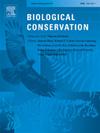Population increases of the threatened American burying beetle (Nicrophorus americanus) linked to large-scale collaborations in a working lands ecoregion
IF 4.4
1区 环境科学与生态学
Q1 BIODIVERSITY CONSERVATION
引用次数: 0
Abstract
Woody plant encroachment and row-crop agricultural land conversion are existential threats to species that rely on grassland ecosystems. The American Burying Beetle (Nicrophorus americanus) is a threatened species whose largest remnant populations are predominantly located in grassland ecoregions comprised of privately-owned ranching lands. Here, we seek to determine functional scaling patterns and population trends of the American Burying Beetle in the face of conservation threats and grassland restoration. We used 13 years (2007–2019) of American Burying Beetle abundance data collected from permanent sampling locations across the Loess Canyons ecoregion (Nebraska, USA), where a network of ranchers have been restoring large-scale grasslands. To estimate beetle abundance relative to land cover variables, we developed a Bayesian N-mixture model, incorporating the Bayesian latent indicator scale selection (BLISS) method to probabilistically determine at which scales land cover variables best explained beetle abundance. American Burying Beetle abundance exhibited high interannual variation but overall significantly increased across the ecoregion. Increases in beetle abundance were associated with large-scale (1149 ha extent) grassland cover. Decreases in abundance were associated with large-scale crop conversion (590 ha extent) and large-scale increases in woody cover (1149 ha extent). This study provides the first evidence of ecoregion-scale population increases of the American Burying Beetle. These increases are tied to landscape variables that are managed in a large-scale, coordinated private lands grassland restoration effort. Our results suggest that successful grassland restoration will depend on coordinating across property boundaries to implement conservation at scales necessary to conserve species that require large-scale, unfragmented grasslands.
受威胁的美洲掩埋甲虫(Nicrophorus americanus)种群增加与工作地生态区的大规模合作有关
木本植物蚕食和连作农田转换对依赖草原生态系统的物种构成了生存威胁。美洲埋甲虫(Nicrophorus americanus)是一种濒危物种,其最大的残存种群主要位于由私有牧场组成的草原生态区。在此,我们试图确定美洲埋甲虫在面临保护威胁和草原恢复时的功能缩放模式和种群趋势。我们使用了从黄土峡谷生态区(美国内布拉斯加州)永久性采样点收集的 13 年(2007-2019 年)美洲埋甲虫丰度数据,该生态区的牧场主网络一直在恢复大规模草地。为了估算甲虫丰度与土地覆被变量的相关性,我们建立了一个贝叶斯 N-混杂模型,并结合贝叶斯潜指标尺度选择(BLISS)方法,以概率方式确定在哪个尺度上土地覆被变量最能解释甲虫丰度。美洲埋甲虫丰度的年际变化很大,但在整个生态区域总体上显著增加。甲虫丰度的增加与大规模(1149 公顷范围)草地覆盖有关。甲虫数量的减少与大规模作物转化(590 公顷范围)和大规模林木覆盖面积增加(1149 公顷范围)有关。这项研究首次提供了生态区域范围内美洲埋甲虫种群数量增加的证据。这些增长与大规模、协调的私人土地草地恢复工作中管理的景观变量有关。我们的研究结果表明,成功的草原恢复将取决于跨越财产边界的协调,以必要的规模实施保护,从而保护那些需要大规模、未被分割的草原的物种。
本文章由计算机程序翻译,如有差异,请以英文原文为准。
求助全文
约1分钟内获得全文
求助全文
来源期刊

Biological Conservation
环境科学-环境科学
CiteScore
10.20
自引率
3.40%
发文量
295
审稿时长
61 days
期刊介绍:
Biological Conservation is an international leading journal in the discipline of conservation biology. The journal publishes articles spanning a diverse range of fields that contribute to the biological, sociological, and economic dimensions of conservation and natural resource management. The primary aim of Biological Conservation is the publication of high-quality papers that advance the science and practice of conservation, or which demonstrate the application of conservation principles for natural resource management and policy. Therefore it will be of interest to a broad international readership.
 求助内容:
求助内容: 应助结果提醒方式:
应助结果提醒方式:


